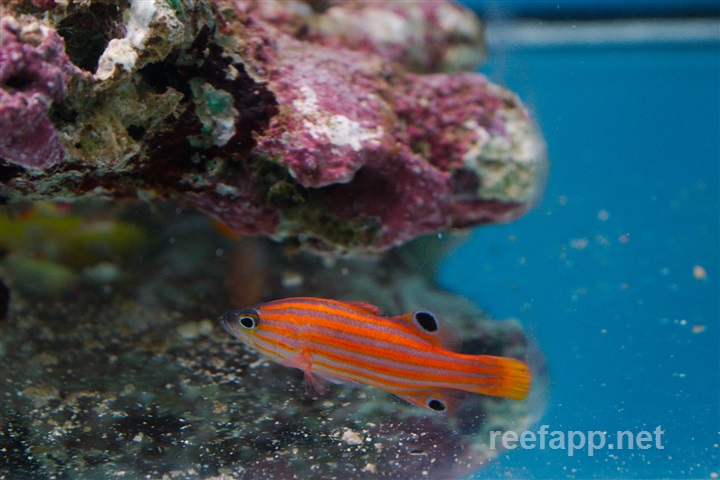Liopropoma swalesi


| Latin name | Liopropoma swalesi - (Fowler & Bean, 1930) |
|---|---|
| Local name | Swales' basslet |
| Family | Serranidae - Liopropoma |
| Origin | Australia, Indonesia, Central/West Pacific |
| Max length | 5 cm (2") |
| Minimum volume |
50 l (13 gal) |
|---|---|
| Hardiness |
Average |
| Suitable for aquarium |
Suitable with care |
| Reef safe |
Always reef safe |
| Aggressiveness | Docile but might be aggressive towards similar species |
| Recommended |
Small crustaceans (Krill, mysis, artemia...) Zooplankton (Cyclops, pods...) |
|---|---|
| Mostly |
Larger crustaceans (Shrimp, crabs...) |
This species is known to jump out of open aquaria.
This species thrives best in an aquarium with dimmed lighting.
This species can be a threat towards small crustaceans, e.g. small shrimp.
This species must be fed with an appropriately varied diet.
These fish may well hide themselves for a while, whilst getting acclimatized.
Do not disturb the fish while acclimating because it will prolong the process.
A very secretive species which hides between the rocks.
When it feels at home in the aquarium it will appear more, but is still not as active in the water column as most of the other fish.
They can live as a pair provided they are introduced simultaneously.
This species needs good hiding places, for example, between live rocks.
This species is very shy and docile, so one should be careful when keeping it with more aggressive fish.
Of the Seranidae family, the Reef Basslets (Liopropoma) contain some of the smallest species. Because of their size, they are eminently suitable to smaller aquaria.
They are normally very shy and therefore are best placed in a tank with very peaceful fish, or as an single species in i.e. a nano aquarium.
As these fish live in deep water, they can be encouraged to be more forward by dimming the lighting.
The Sea Bass family (Serranidae) spans a broad spectrum with regards to how suitable they are to aquaria, as some are best suited to specialist or larger aquaria, while other are often seen in reef aquaria.
Below are described the five subfamilies one sees most often in aquaria. There are however other species one can also keep under the right circumstances, but these are for the most, large predatory fish.
Anthias (Anthiinae)
The Anthias species spans over many different genera, but the most common is the Pseudanthias genus. They mostly have an attractive orange or pink shade.
They are generally all reef safe and peaceful.
There is however a large difference to their food requirements, some species demand constant feeding, whereas others can get used to being fed once a day.
The easiest species are the following: P. bartelettorum, Anthias, Luzonichthys, Nemanthias, Odontanthias, Pseudanthias, Sacura and Serranocirrhitus
Liopropomatinae
This subfamily encompasses some of the smallest fish in the Serranidae family, they can be very colourful but shy. The Liopropoma genus encompasses many species which are suitable for aquaria, however they normally thrive best in a very peaceful- or nano aquarium.
Grouper (Epinephelinae)
These fish grow typically too large for most home aquaria. There are however some species that do lend themselves to the slightly bigger domestic aquarium. Several of the species look very impressive and often have a interesting personality, and they often recognize the aquarist and will become tame over time.
Groupers are predatory fish and eat everything they can swallow; fish, crabs, shrimps and sometimes other invertebrates. Like most large predatory fish they excrete a lot of nutrients to the water, so one therefore needs a good filter system.
Groupers include among others the following genera: Aethaloperca, Cephalopholis, Chromileptes, Epinephelus, Paranthias and Pogonoperca
Soapfishes (Grammistinae)
These fish are like the Groupers predatory fish, but they do not typically, grow so large. They are relatively hardy, but some of the species demand a thorough preperation if one wants to be successful.
Soapfishes are generally very shy and will often hide under an overhang during the day, and hunt at night.
Soapfishes include among others the genera: Grammistes
Serraninae
The most common genera in captivity is Dwarf Seabasses (Serranus) and Hamlets (Hypoplectrus).
See the description of the individual genera below.
| Distribution | Western Pacific: Vanuatu, Philippines, Indonesia and New Britain, Papua New Guinea |
|---|---|
| English common names |
Swales' basslet Orange-lined reef basslet |
Scott W. Michael. Reef Basslets & Grammas - Part 1 - Live Aquaria (English)
Scott W. Michael. 2001. Basslets, Dottybacks & Hawkfishes: v. 2 (Reef Fishes) - TFH Publications / Microcosm Ltd. - (English)
Bob Fenner. The Basslets of the Genus Liopropoma - Wet Web Media - (English)
WWM Crew. FAQs about the Basslets of the Genus Liopropoma - Wet Web Media - (English)
Henry C. Schultz. 2004. Care to Go Spelunking? The Genus Liopropoma - Reefkeeping.com - (English)
Gregory Schiemer. 2006. Aquarium Fish: The Candy Basslet (Liopropoma carmabi (Randall, 1963)) - Advanced Aquarist - (English)
Bob Fenner. The Basses, Family Serranidae - Wet Web Media - (English)

